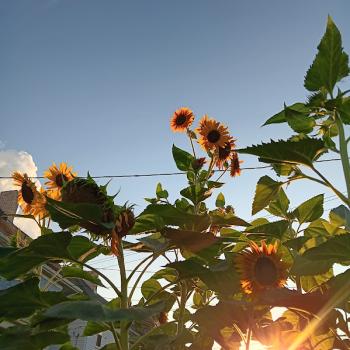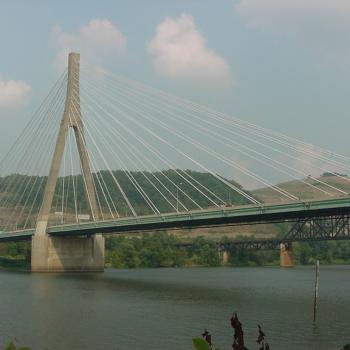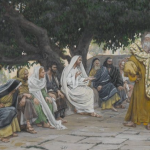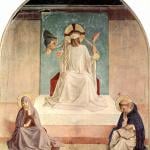Mountains Older than Bones
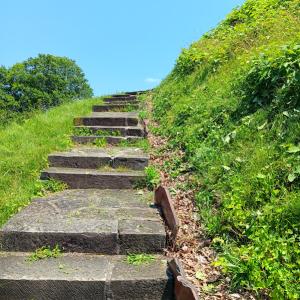
On Wednesday, we went to Moundsville.
“Going to Moundsville” is a slang term for going to jail around the Valley, because they have a historic state prison that’s now a museum. There is an electric chair name Old Sparky, and other things I never want to see, on display for fifteen dollars. But Moundsville also has an ancient Adena burial mound, the grave of at least three prehistoric humans, a much bigger mound than the one in Tiltonsville. I love learning about the Adena and I always wanted to see the mound. I needed a long day out after all this rain. We’ve had more rainy days than not lately, but now, it was a brilliantly sunny day. I bribed Adrienne with an ice cream at the Dairy Queen if she’d be my travelling companion for the day. We dropped Michael at work, and we got on the road.
Moundsville is at the bottom of the chimney of West Virginia. I wouldn’t recommend crossing the bridge at Wellsburg and taking Route Two all the way down if you go there. You ought to take Route Seven on the Ohio side of the river, then cross at Shadyside. But Adrienne and I took the West Virginia side, to see more of the state. Route 2 is a skinny road with one lane each way. On the west side of Route 2 is the Ohio river, flanked by rusted wrecks of industry that used to be here. On the east side is a series of shale hills, the foothills of the Appalachian mountains, a mountain range some people call “older than bones” because they were formed at about the same time as the evolution of vertebrate life.
Route 2 starts out as a highway with highway speeds, and then abruptly slows to 35 miles per hour as the highway turns into the main street of a town, then into the wilderness and back up to 50 again just when you’re used to it. First, we drove through Beech Bottom. Then we saw Short Creek and Warwood, and then the beautiful but confusing city of Wheeling where we got lost twice. Eventually, the road spit us out south of Wheeling. The next time the speed limit slowed, we’d reached our destination.
That prison I didn’t want to visit was directly across the street from the mound.
One one side of the road, there was a great gray rectangle with towers and battlements on top, like a castle from a fairy tale, decorated with a plaque bearing the Seal of the State of West Virginia. On the other side was a cone-shaped grassy hill, and a little brick museum.
The museum displayed the remains of a stegodon, which looks like a mammoth. Stegodons, like elephants, didn’t have any bones in their trunks, so the big black skeleton in front of me had two long white tusks on either side of an awkward grinning mouth. There was also a dimetrodon, a sail-backed creature that looked like a dinosaur but was older than the first dinosaurs. There was a small diorama where toy Adena warriors were killing a toy stegodon in the forest with their spears. There was a second diorama, of the Adena performing a ritual in a round house made of sticks, and a third diorama of the Adena burying a body in the mound 2200 years ago. There was a display explaining that the Adena people left no written language, only petroglyphs carved in the shale, and that they died long before white settlers ever came here. There was a display about the conspiracy theories that the mound and the petroglyphs had been built by a lost civilization, or possibly the Vikings, because Victorian archeologists didn’t want to admit that Indigenous people could be architects. At the back of the museum was a door to the outdoors, and the mound itself.
There was a stone staircase spiraling up the side of the mound, with a sign warning tourists to stay on the stairs and not step on the grass.
I had never walked on an Adena monument before.
I only got halfway. I am terrified of heights. Around the west side of the structure, I had a dizzy spell. I sank to my knees on the stone slab, my head swimming.
In the bright, blazing sun, in the sweltering humidity of a terribly rainy June, I panted for breath. To my right was a steep grassy incline, pleasantly warm in the afternoon sun. To my left was a steep drop, the museum building, and the city of Moundsville. I could see a red brick steeple off to one side, from a Catholic church built in 1854. To the north was the courthouse, built in 1875. Beyond the city were the foothills of the Appalachian Mountains, larger than the ones in Steubenville, older than the dinosaurs. Straight across the road was the penitentiary where ninety-four men were put to death by the State of West Virginia. I was resting beside the bones of three human beings who ate the meat of stegodons and carved petroglyphs in the shale rock, thousands of years before there was such a thing as West Virginia at all.
Somehow I made my way back down.
We got our ice cream, and headed back to Steubenville.
That night, it rained again. It rained the rest of the week. The rain was so heavy that it overwhelmed the Valley. Over the weekend I learned of the flash flooding, all along northern West Virginia. Flash floods ravaged the towns along Route Two. Flash floods wreaked havoc in all the places we’d been. Flooding destroyed houses and carried cars away. It claimed seven lives in the confusing city of Wheeling. A three-year-old child was dead, and more are missing. More flash flooding is expected this evening.
It’s been raining since.
It feels as if it will rain forever.
Mary Pezzulo is the author of Meditations on the Way of the Cross, The Sorrows and Joys of Mary, and Stumbling into Grace: How We Meet God in Tiny Works of Mercy.





